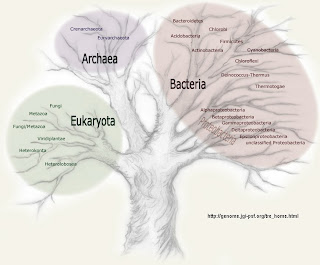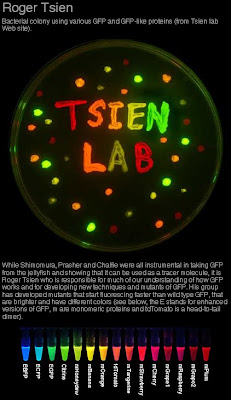Ford introduced the topic from three perspectives: science, philosophy, and politics. The science is straightforward. You can construct perfectly respectable gene trees for bacteria using all kinds of different genes. Problem is, the trees aren't congruent. They don't agree with each other. This is well-established scientific fact and you need to accept it if you're ever going to understand the issue.
The trees aren't wildly different in most cases and it's possible to make sense of them by postulating the transfer of genes from one species to a different species. This is horizontal gene transfer (HGT), as opposed to the normal vertical gene transfer from generation to generation. It's more common to use the term lateral gene transfer (LGT). There are three very well studied modes of transfer: conjugation, transduction, and transformation.
The scientific evidence shows clearly that early phylogenetic relationships among bacteria cannot be accurately represented by a single tree. The proper relationship is a net, network, or a web. Again, this is not controversial among those scientists who are aware of the data. The facts and the conclusion have been around for over a decade. There is no "tree of life" representing the early evolution of life on Earth.

The philosophical questions have to do with the usefulness of metaphors in science (e.g. tree) and the implications for understanding the history of biology. Do we need to abandon all talk of trees? Is "Darwinism" committed to tree-like interpretations of evolution? Ford spent more time than I would have liked discussing Darwin's thoughts about trees and, unfortunately, the famous New Scientist cover was prominently on display.
Later on, Ford made the point that we need to move beyond Darwinism to postDarwinism and I agree with this point. That's why we need to stop talking about what Charles Darwin did, or did not, believe. He was wrong about a lot of things, but he died over 125 years ago.
The politics part of the talk refers to the fact that questioning the tree of life cases problems for those who are fighting creationists. By challenging a fundamental concept in evolutionary biology we are lending support to the creationists. Ford said that he understands why Genie Scott and the people at NCSE might be upset about this and he understands why there might be some value in focusing on the validity of animal trees instead of drawing attention to the problems with bacterial trees.
Most people at the meeting felt that NSCE and everyone else involved in fighting creationists just have to suck it up and deal with the scientific facts.
 The next talk was by Jan SappProfessor of Biology at York University in Toronto (ON, Canada). Sandwalk readers will recall that I devoted several postings to discussing his book on the Three Domain Hypothesis some years ago.
The next talk was by Jan SappProfessor of Biology at York University in Toronto (ON, Canada). Sandwalk readers will recall that I devoted several postings to discussing his book on the Three Domain Hypothesis some years ago. The title of Jan's talk was Thinking laterally on the tree of life. He emphasized history of trees in biology and the history of lateral gene transfer, including hybridization and symbiosis. As it turns out, scientists have been thinking about non-treelike inheritance for more than 100 years.
Jan has a new book coming out that will discuss this history and its implications for a new view of evolution.
The third speaker was Ian Hacking, Professor of Philosophy at the University of Toronto (ON, Canada). He talked about The Fatal Attraction of Trees. The idea is that we all have a preference for organizing information in a treelike manner and this bias gets in the way of accepting a different view of evolution.
Olivier Rieppel works at the Field Museum in Chicago (IL, USA). His talk was about The series,the network, and the tree: Changing metaphors of order in nature. Olivier spent some time on cladism and cladistics and raised interesting questions about the validity of cladism as an approach to phylogeny.
Here's the problem: even in vertebrates, the gene trees don't always agree with the morphological trees. Olivier works with snakes and lizards and sorting out the "true" evolutionary history is extremely difficult. Is there a lot of LGT in vertebrates? Is it possible that we might have to abandon trees even at the this level?
Rob Beiko works in the Faculty of Computer Science at Dalhousie University in Halifax (NS, Canada). He showed us how LGT can mess up your trees. He developed computer simulations to illustrate the effect of lateral genes transfer under various condition. The good news is that reasonable frequencies of lateral gene transfer don't completely obscure the underlying treelike phylogeny.
Yan Boucher is a postdoc at MIT in Boston (MA, USA). His talk was Evolutionary Units: Breaking down species concepts. The main idea was that we should not consider species as the unit of evolution, instead, the appropriate unit is a piece of DNA. This was by far the most controversial talk. Several participants, including me, were quite confused by the presentation. We weren't aware of the fact that a species was considered a unit of evolution.
The next speaker was Peter Gogarten of the University of Connecticut in Storrs (CT, USA). Peter showed us many examples of lateral gene transfer in bacteria.
Joe Velasco is in the Dept. of Philosophy at Stanford University in Palo Alto (CA, USA). He told us about strategies for Inferring phylogenetic networks from a hypothetical computational approach. The bottom line is that it make be possible to construct networks—as opposed to trees—using computer programs but it's going to take a huge amount of effort.
After the talks we retired to the pub at the University Club and dinner in the dining room (salmon). There's was much conversation. At my table the most interesting debates were about sex and race with Andrew Roger and Ford Doolottle.
And so endeth the first day.






















